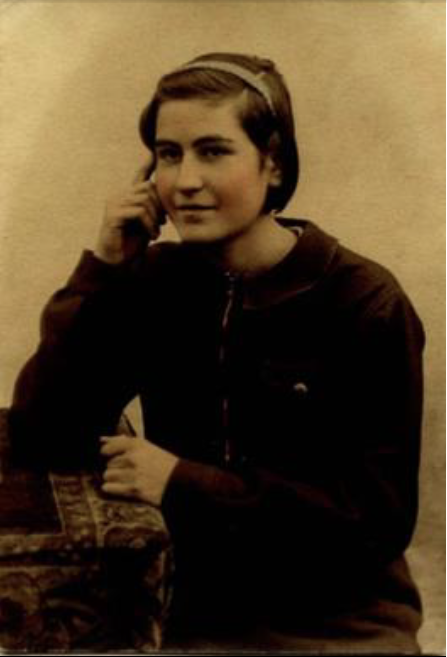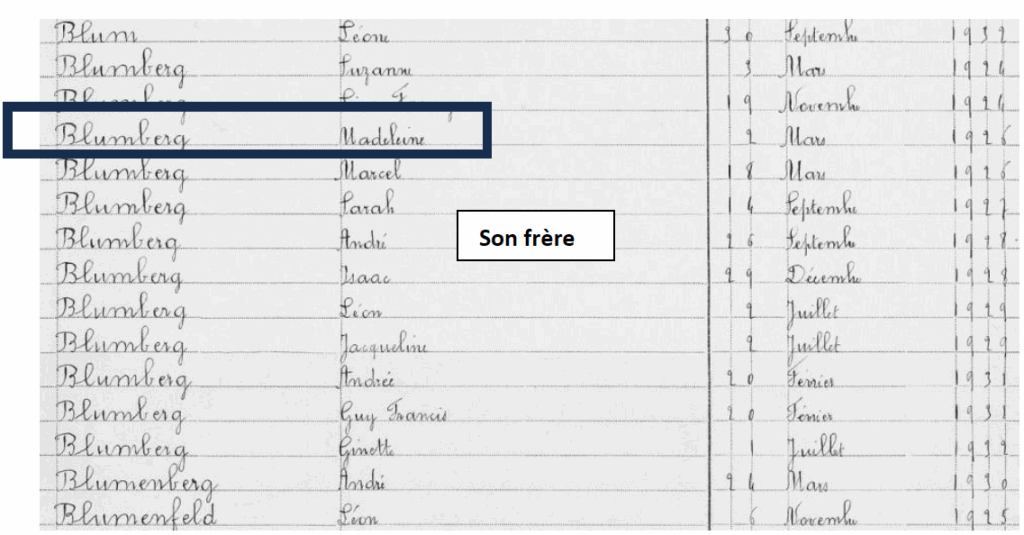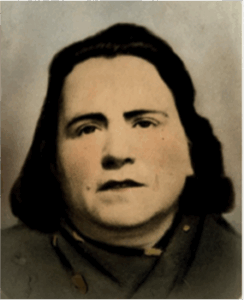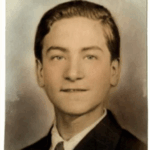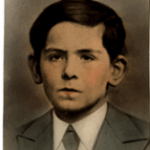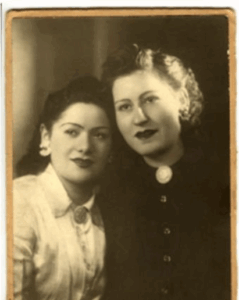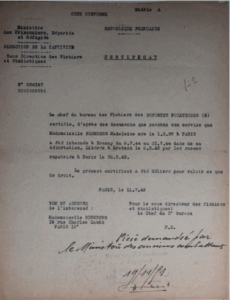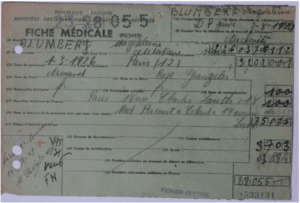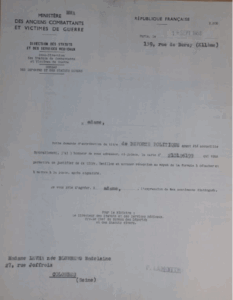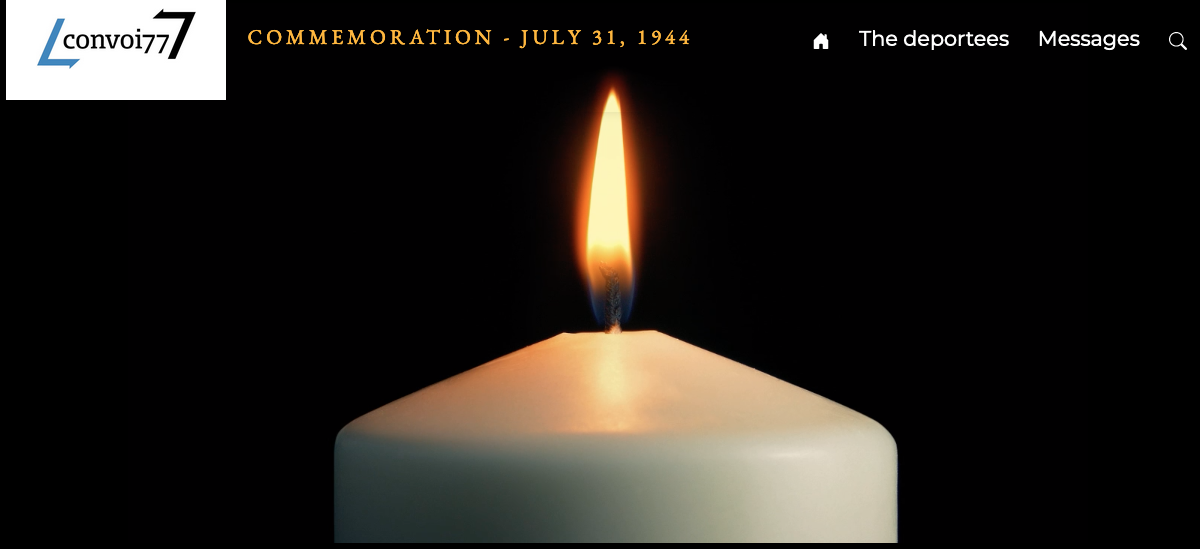Madeleine BLUMBERG
Photo of Madeleine Blumberg. Source: © family photograph belonging to Lionel Levha, Madeleine Blumberg’s son
Madeleine Blumberg (married name Levha) was born on March 1,1926 in the 12th district of Paris. The ten-year birth register lists the date as March 2, however.
Ten-year register of births in the 12th district
Source: Madeleine Blumberg © Paris archives
Her parents were Ybersz Armand Blumberg, who was born in Warsaw, Poland and Rose Blumberg, née Krantzler, who was born in Constantinople in Turkey. Both were Jewish and were naturalized as French citizens on March 6, 1929. They lived in the 18th district of Paris.
Armand and Rose Blumberg
Source: © family photographs belonging to Lionel Levha, Madeleine Blumberg’s son
Madeleine was the couple’s second child. Her older sister Anna Léone, was born in 1922. Her four younger siblings were: André, born in 1928, Serge, born in 1930, Simone, born in 1932 and Alain Louis who was born in 1944 in Drancy internment camp.
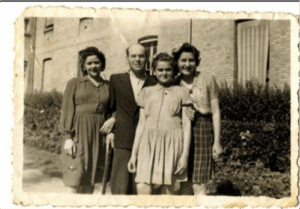
Anna, her father Armand, Simone and Madeleine
Source: © family photograph belonging to Lionel Levha, Madeleine Blumberg’s son
André and Serge
Source: © family photographs belonging to Lionel Levha, Madeleine Blumberg’s son
Alain Louis
The only member of the family of whom we have no photos, because Alain was born in Drancy camp and murdered in Auschwitz-Birkenau. He was just two weeks old.
She began her education at the nursery school in Gennevilliers, the town in which Simonne was born, and then went to the girls’ school on Rue de Torcy in the 18th district of Paris, not far from Rue de La Chapelle.
According to her son, Madeleine was close to her brothers and sisters, especially her two brothers André and Serge, with whom she “got into mischief”. She had a happy childhood, even though her father was quite strict.
In 1935, when a new low-cost housing complex was built, she and her family moved into an apartment at 18 rue Charles-Lauth on the periphery of the 18th district of Paris.
In late 1943, when life Paris became too difficult, the parents decided to send the two younger children, Serge and Simone, to stay with a Mrs. Boulland and a Miss Simon on a farm (L’Herbage in Couterne) in the country in the Loiret department of France. However, in January 1944, financial constraints and a heavy workload left the two women with no choice but to keep Simone with them (which ultimately saved her life) but send Serge back to Paris.
Madeleine was 18 years old in 1944.
Anna and Madeleine
Source: © family photograph belonging to Lionel Levha, Madeleine Blumberg’s son
The arrest
The Gestapo arrested the family in their apartment at around 1 a.m. on the night of July 7-8, 1944. The Grinberg family, who lived in the same building, was also arrested that night. The circumstances surrounding the arrest (which took place as a result of “a deliberate or unintentional tip-off by someone else who lived in the building”) are described in a record in Armand Ybersz Blumberg’s file.
Madeleine was taken away with her father, Armand, her pregnant mother, Rose, and her three siblings, Anna, André and Serge. They were interned in Drancy camp, north of Paris, where they remained for 23 days.
Madeleine was assigned the prisoner number 24,952. The word “fam” on her registration card (which was yellow, meaning that she could be deported immediately) signified that she had arrived together with her family. Her normal identity papers were no longer valid after July 8, the day on which she was booked in.
Her mother gave birth to a baby boy, Alain Louis, on July 17.
Deportation to Auschwitz-Birkenau
On July 31, 1944, the Blumberg family was deported on Convoy 77 to Auschwitz-Birkenau. The baby, Alain-Louis, was transported in a little box lined with muslin.
When the train arrived in Birkenau during the night of August 3-4, 1944, Rose and little Alain-Louis were immediately put on a truck that took them to the gas chambers, where they were murdered.
Serge and André were selected to enter the camp for forced labor. There is a record of Serge being held in the Sachsenhausen camp in December 1944. André was admitted to the Auschwitz infirmary, the “revier”, in January 1945, shortly before the camp was liberated. We found no further trace of him after that.
Madeleine, Anna and their father Armand were also selected for work.
Madeleine had the number A 16.681 tattooed on her forearm. During her time in the Birkenau camp, she stayed in blocks 14, 16 and 18. She remained there for “three months”.
According to a certificate dated July 11, 1945, based on an interview with her when she returned to France[1], she was sent to work in the Kratzau camp in the Sudetenland in Czechoslovakia in September 1944. It is more likely to have been in October, however, which is when a number of other women from Convoy 77 were transferred there. During her time in Kratzau, her prisoner number was 16681.
Along with 120 other women, she walked to the rail line where a train made up of cattle cars was waiting for them. According to Régine Skorka-Jacubert, another Convoy 77 survivor, there were at least 100 women crammed into each car, and they traveled nearly 200 miles in two days, just as the Red Army was closing in[2].
During her time in Kratzau, Madeleine worked in a munitions factory. “We worked twelve hours a day, tormented by hunger” wrote Régine Skorka-Jacubert. Madeleine estimated that there were 1,100 women working in the factory.
The Soviet army liberated the Kratzau camp on May 8, 1945.
The return to France
Madeleine survived her time in the camps. She later said she was repatriated by train “by the Americans”. She arrived at the Saint-Avold reception center, in what is now the Moselle department of France, on May 28, 1945.
Her medical report, in which she was described as a “deported Jew” includes very little information about her state of health. It was reported to have been “average” (which does not mean much) and the form is barely legible. In common with most of the other women survivors, she suffered from amenorrhea. She stated she had lost 10 kg (around 22 llbs), but her weight was not noted on the form.
Madeleine, who knew what had happened to her mother but had no idea that her father had survived, said that she was intending to go to stay with a Mrs. to Percaust at 19 Avenue de Lutèce in Colombes, rather than return to the family apartment.
According to her son, Madeleine contracted tuberculosis, which affected her breathing for the rest of her life.
In a questionnaire dated July 1945, Madeleine is listed as living at 18 Rue Charles-Lauth in Paris, so at some point since she returned to France, she had moved back into her parents’ apartment.
Certificate issued by the French Ministry for Prisoners, Deportees, and Refugees
Source: Madeleine Blumberg © Victims of Contemporary Conflicts Archives Division of the French Ministry of Defense Historical Service, in Caen, Dossier n°21 P 563 43474910
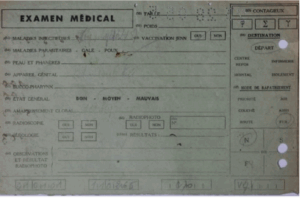
Medical exam report card
Source: Madeleine Blumberg © Victims of Contemporary Conflicts Archives Division of the French Ministry of Defense Historical Service, in Caen, Dossier n°21 P 563 43474910
Medical form
Source: Madeleine Blumberg © Victims of Contemporary Conflicts Archives Division of the French Ministry of Defense Historical Service, in Caen, Dossier n°21 P 563 43474910
After the war
Madeleine married Georges Levha in Algiers in the early 1950s. The couple had their first son, Lionel, in 1956, and their second, Gilles, in 1958. In 1958, she was living at 8 Rue Ernest-Renan in the 15th district of Paris, and in 1959, she was living at 27 Rue Joffroix in Colombes, in the northwestern suburbs of Paris. In September that year, the family moved to 8 rue Jean-Bouveri in Boulogne-sur-Seine (now Boulogne-Billancourt), to the west of the city.
On July 30, 1959, she was granted the status of political deportee, meaning that she was deported for political reasons, on the grounds that she was an “Israelite”, i.e. Jewish. She received her political deportee card on September 14, 1958.
Covering letter sent with Madeleine’s political deportee card
Source: Madeleine Blumberg ©Victims of Contemporary Conflicts Archives Division of the French Ministry of Defense Historical Service, in Caen, Dossier n°21 P 563 43474910
In January 1960, Madeleine received a check for 13,200 francs in compensation for her internment in Drancy and subsequent deportation. That is equivalent to less than $300 in today’s money.
Like many deportees, Madeleine rarely spoke to her children about what she had been through.
She even told them that she was the only survivor, when in fact Anna, Simone, and her father Armand had also survived. She does appear to have kept in touch with her father, however.
Madeleine died on April 14, 2004 in Boulogne-Billancourt.
It was not until after she died that her son got in touch with his cousin Josiane, Anna Léone’s daughter.
We would like to thank Mr. Lionel Levha, Madeleine Blumberg’s son, for sharing the Blumberg family’s memories with us. Thank you too for allowing us to publish the family photographs.
[1] AN F9 5583. Interview conducted by Mr. Seignol at 5 o’clock on July 11.
[2] Régine Skorka-Jacubert, Fringale de vie contre usine de mort (Thirst for life versus the death factory), published by Le manuscrit éditions, 2009, p.173-195.


 Français
Français Polski
Polski